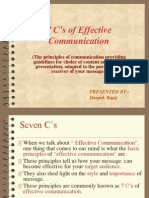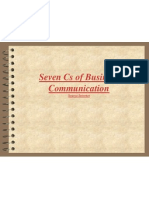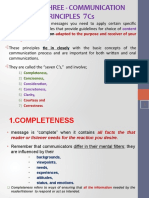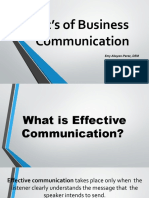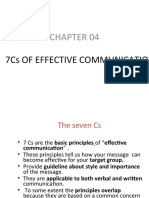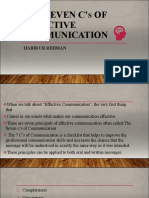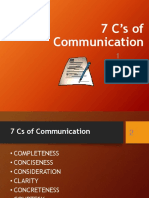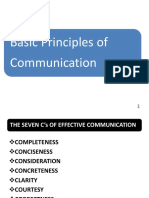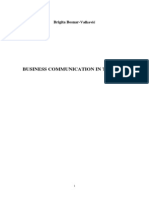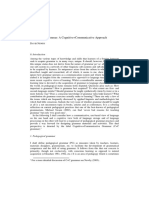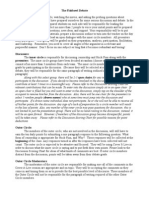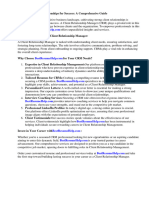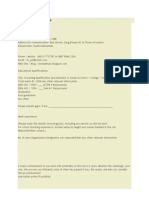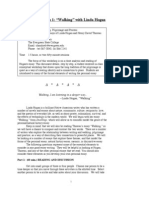CHAPTER THREE
BUSINESS COMMUNICATION PRICIPLES
7 c’s of Business communication principles
1. Completeness
2. Conciseness
3. Consideration
4. Concreteness
5. Clarity
6. Courtesy
7. Correctness
1. COMPLETENESS –The message or communication is “complete” only when it contains all
facts the reader or listener needs for the reaction that desire. Remember that communications
differ in their mental filters; they are influenced by individuals’ backgrounds, viewpoints, needs,
experiences, attitudes, status, and emotions.
Completeness is necessary for several reasons.
• First, complete messages are more likely to bring the desired results without the expense
of additional messages.
• Second, they can do a better job of building good will.
• Third, papers that seem unimportant be surprisingly important if the information they
contain is complete and effective.
• In high-level conferences, in courtrooms, and in governmental hearings, the battle often
centers on an ordinary - looking message that becomes important because of the complete
it contains.
While striving for completeness, keep the following guidelines in mind:
• Answer all questions asked.
• Give something extra, when desirable.
• Check for the five W’s and any other essentials.
1
�i. Answer all questions asked
Whenever you reply to an inquiry, try to answer all questions-stated and implied. A prospective
customer’s reaction to an incomplete reply is likely to be unfavorable. The customer may think
the respondent is careless or is purposely trying to conceal a weak spot.
ii. Give something extra, when desirable
The words “When desirable”, in the above heading, are essential. Sometimes you must do
more than answer the customer’s specific questions. They may not know what they need, or their
questions, may be in inadequate.
iii. Check for the five W’s and any other Essentials
Another way to help make your message complete is to answer, whenever desirable, the “ five
W” questions-who, what, where, when, why-and any other essentials, such as how. The five-
question method is especially useful when you write requests, announcements, or other
informative messages.
For instance, to order (request) merchandise, make clear what you want, when you need it, to
whom and where it is to be sent, and how payment will be made. To reserve a hotel banquet
room, specify the accommodations needed (what), location (where), sponsoring organization
(who), date and time (when) event (why), and other necessary details (how).
2. CONCISENESS
Conciseness is saying what you have to say in the fewest possible words without sacrificing the
other C qualities. Conciseness contributes to emphasis. By eliminating unnecessary words, you
help make important ideas stand out.
To achieve conciseness try to observe the following suggestions:
A. Eliminate wordy expressions
B. Include only relevant statements
C. Avoid unnecessary redundancy
A. Eliminate wordy expressions
i. Use single-word substitutes instead of phrases whenever possible without changing
meanings.
2
� Wordy Concise
-Along the line of salary at this time -About salary now
-Consensus of opinion in accordance -Consensus as u requested
with your request
- Please don’t hesitate to write -Please write
ii. Omit trite expressions-expressions too often used and so dull /uninteresting; not new or
original.
Trite Expressions Concise (original) expressions
-Allow me to say -Please be advised
-Please find attached -Attached are
-Please find enclosed -Enclosed is
iii. Omit “which” and “ that ” clauses whenever possible.
Wordy:- She bought desks that are of the executive type
Concise:- She bought executive-type desks.
B. Include only Relevant Statements
The effective, concise message should omit not only unnecessarily wordy expressions but also
irrelevant material. To be sure you include only relevant facts, observe the following
suggestions;
1. Stick to the purpose of the message.
2. Prune irrelevant words and rambling sentences. (Not properly connected sentences).
3. Omit information obvious to the receiver; do not repeat at length what that person has already
told you.
4. Avoid long introductions, unnecessary explanations, excessive adjectives and prepositions,
gushy politeness.
5. Get to the important point tactfully & concisely
C. Avoid unnecessary Repetition
3
�Sometimes repetition is necessary for emphasis. But when the some thing is said two or three
times without reasons, the message becomes wordy and boring. Here are three ways to eliminate
unnecessary repetition.
1. Use a shorter name after you have mentioned the long one once: Instead of the “ Thompson
product Manufacturing Company ”, “ Thompson Company ”.
2. Use pronouns or initials rather than repeat long names: Instead of Citing “ National mining
corporation, S.C ” again and again, use “ it ” or “ they ” or “ MMC ”
3. Cut out all needless repetition of phrases & sentences.
3. CONSIDERATION
The interrelationship of the message, sender and receiver profoundly affects communication
effectiveness. Consideration means that you prepare every message with the recipient in mind
and try to put yourself in his or her place. Try to visualize your readers (or listeners) –with their
desires, problems, circumstances, emotions, and erasable reactions to your request. Then handle
the matter from their point of view. This thoughtful consideration is also called “you-attitude”,
empathy, the human touch /feel, and understanding of human nature.
In all four specific ways you can indicate you are considerate:
• Focus on “ you ” instead of “ I ” “ We ”
• Show reader benefit or interests in reader.
• Emphasize positive, pleasant facts.
• Apply integrity and ethics.
A. Focus on “ you ” instead of “ I ” and “ We ”
Your receivers are usually more concerned about themselves than about you or the company
you represent. They are more likely to read your message when they see their name and the
pronoun “you ” rather than “ I ”, “ we ”, or “ us ”.
Usually it is desirable to get your reader in to the first paragraph. If psychological desirable,
begin with “you”, and keep your reader in the message (tactfully) until you finish. The opposite
of the you-attitude is the we-attitude, in which the writer views every matter from his or her own
(or the organization’s) standpoint rather than from the reader’s.
4
�Evaluate the following examples:
We-Attitude
• May I take this opportunity to express my thanks for the account you recently opened
with our store. We are pleased to furnish a wide variety of products for the home or
individual. You-Attitude
• Thank you for the account you recently opened at Bekinson’s. Serving you with your
needs for clothing & a home furnishing is a pleasure.
• As the foregoing example illustrate, a letter is likely to have better you attitude when it
contains more “You’s ” than “ I’s ”. But there are notable exceptions;
In two kinds of situations it is advisable not to use “ You ”
1. When the reader has made a mistake.
Poor:- You failed to enclose your check in the envelope
Better:- The envelope we received did not have a check in it
2. When the reader has expressed an opinion different from your own:
Poor:- You are entirely wrong in your attitude.
Better:-The proposed plans has three aspects which are extremely important and which we need
to explain now.
B. Show Reader Benefit or Interest in Reader
• Whenever possible and true, show how your reader will benefit from whatever the
message asks or announces. They will be more likely to react favorable and do what you
suggest if you show that benefits are worth the effort and cost.
C. Emphasize the Positive, Pleasant Facts
• A third way to show consideration for your reader (or listener) is to focus the positive.
This means (1) stressing what can be done instead of what cannot be done. And (2)
focusing on words your recipient can consider favorably.
Statement of What Can Be Done
5
� • The reader (listeners) wants to know what you can do for him or her. For most people
negative words like no, won’t, cannot, never, impossible trigger unpleasant emotional
reactions.
Words Your Recipient Can Consider Favorably
Among the positive words of which people react favorable are benefits, cordial/ pleasant, happy,
help, generous, loyal, pleasure, thanks, thoughtful. Words with negative connotations that often
arouse unfavorable reactions include blame, complaint, failed, fault, negligence, regret, reject,
trouble, unfair, and many others.
D. Apply Integrity and Ethics
To be truly considerate, you need also to apply Integrity high moral standards, personal
honor, and truthfulness, sincerity-to your written and oral messages. Integrity is in social in our
jobs, in business transactions, in social and political activities, in everything we do. Without it,
business communications would prove worthless, and our confidence in people would be
shattered.
4. CONCRETENESS
Communicating concretely means being specific, definite/ exact, and vivid rather than vague and
general. The following guidelines should help you compose concrete, convincing messages:
Use specific facts and figures.
Put action in your verbs.
Choose vivid, image-building words.
A. Use specific facts and figures
• Whenever you can, substitute an exact statement of a figure for a general word make your
message more concrete and convincing. (have a look on some ex. In the hard copy)
• Often vague, general words are opinion words; they may have different meanings to the
sender & the receiver. For instance, how fast is fast? A bicycle rider and a racing-car
driver will have different meanings for this word. How large is large? A person reared in
a village of 150 people may consider a population of 15,000 large, yet to a native of a city
with 10 million inhabitants, 15,000 are very small.
6
�B. Put Action in Your verbs
• Strong verbs can activate other words and help make your sentence definite. To compose
strong sentences, you should:
1) Use active rather than passive verbs and
2) Put actions in your verbs instead of in nouns or infinitives.
C. Choose vivid, Image-Building words
• Among the devices you can use to make your messages forceful, vivid, and specific are
comparisons, figurative language, concrete instead of abstract nouns, and well chosen
adjectives and adverbs,
5. CLARITY
Clarity means getting your messages across the receiver will understand what you are
trying to convey.
You want that person to interpret your words with the same meaning you have in mind.
Accomplishing that goal is difficult because, as you know, individual experiences are
never identical and words may have different meanings to different parsons, as discussed
in earlier chapters.
Here are some specific ways to help your messages clear:
A. Choose short, familiar, conversational words.
B. Construct effective sentences and paragraphs.
C. Achieve appropriate readability (and listen ability).
D. Include examples, illustrations, and other visual aids, when desirable.
A. Choose short, Familiar, Conversational Words
When you have a choice between a long word and a short one, use the short, familiar word that
your reader or listener will quickly understand. Also, avoid technical and business jargon
whenever possible when you talk or write to a person who is not acquainted/ familiar with such
7
�words. If you must use those words, define them briefly and clearly. If you don’t, you will
confuse, embarrass, or irritate the reader, and perhaps be forced to explain later,
B. Construct Effective Sentences and Paragraphs
• Arranging your words in well-constructed sentences and paragraphs is also an essential
task that requires adaptation to your reader.
• Important characteristics to consider are length, unity, coherence, and emphasis.
• Length As Short As Desirable
• A general rule in most business writing is to keep paragraphs as short as possible. If well
organized, they can help to emphasize facts, add to a messages physical attractiveness,
and improve readability
• Unity, To Express Main Ideas (on main idea or topic)
• Coherence, For Clear Meanings
In coherent sentences the words are correctly arranged so that the ideas cleanly express the
intended meaning.
• Unclear. Being an excellent lawyer, I am sure you can help us.
• Clear. Being an excellent lawyer, you can surely help us.
• Clear. As you are an excellent lawyer, I am sure you …
• Unclear. His report was about managers, broken down by age and sex.
• Clear. His report focused on age and sex of managers.
• Clear. His report about managers focused on ………………
C. Emphasis, For Forceful, Clear Expression
• The quality that gives force to important parts of sentences and paragraphs is emphasis.
Writers must decide what needs emphasis, and then choose correct sentences structure. In
a complex sentences the main idea should be placed in the main clause; the less important
points are in subordinate (dependent) clauses or phrases.
D. Include Examples, illustrations, and Other Visual Aids, When Desirable
8
� • In addition to focusing on clarity of words, sentences, and paragraphs, you can also
sometimes use various visual aids effectively.
6. COURTESY
• Courteous messages help to strengthen present business friendship, as well as make new
friends.
• Courtesy stems from sincere / genuine you-attitude.
• It is not merely /only politeness with mechanical insertions of “ pleases ” and ” thank-
yours ”.
• To be courteous
These suggestions regarding tone of the communication.
A. Be sincerely tactful, thoughtful, and appreciative
B. Omit expressions that irritate, hart, or belittle /put down
C. Grant and apologize good-naturedly.
7. CORRECTNESS
The correctness principle comprises more than proper grammar, punctuation, and mechanically
but still insult or loses a customer and fail to achieve its purpose. The term correctness, as
applied to a business message, means the writer should:
A. Check accuracy of figures, facts, and words
B. Maintain acceptable writing mechanics.
C. Choose nondiscriminatory expression.
D. Apply all other pertinent C qualities.
*******

